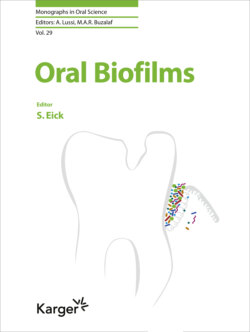Читать книгу Oral Biofilms - Группа авторов - Страница 15
На сайте Литреса книга снята с продажи.
Interactions between Microorganisms
ОглавлениеWhen bacteria undergo the transition from a planktonic lifestyle to biofilm community, they must interact with microorganisms in close proximity [2]. Over a few years it has become clear that a communication among the microbial cells exists and that it plays an essential role in biofilm formation. Bacterial cells and also fungi produce certain molecules to which another microorganism can respond. The molecules produced by Gram-negative bacteria are acyl-homoserine lactones. Gram-positive bacteria may generate autoinducing peptide I and double-tryptophan signal peptide pheromone. Both Gram-positive and Gram-negative bacteria synthesize autoinducer 2, which is of importance in particular in interspecies communication [6]. Quorum sensing is controlled by the spatial distribution and the density of the bacterial cells [6]. In the process of biofilm formation, quorum sensing regulates the attachment of cells to surfaces [6]. Later, it regulates many cell processes, such as cell density in biofilms, exchange of genes, synthesis of bacteriocins, and biofilm dispersion. Synergistic and antagonistic behaviors occur among the microorganisms within a biofilm, for example microorganisms utilize the byproducts of others or compete on nutrients, and they coagregate or blanket the surface to compete for others [7, 8]. The close proximity of many different microorganisms is an important place for genetic exchange. It is of importance to note that it provides a reservoir for transferring antibiotic resistance genes [9].
